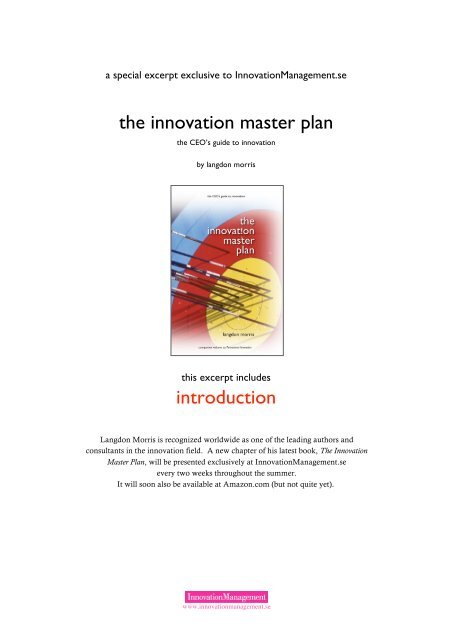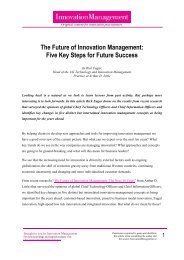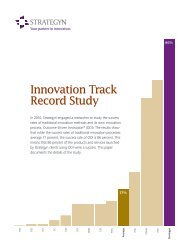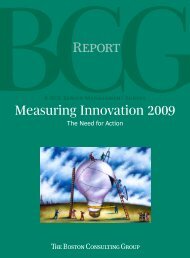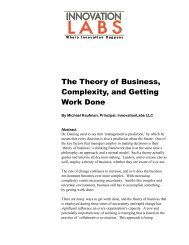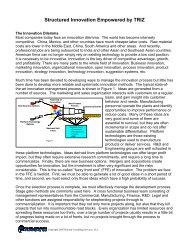the innovation master plan introduction - Innovation Management
the innovation master plan introduction - Innovation Management
the innovation master plan introduction - Innovation Management
You also want an ePaper? Increase the reach of your titles
YUMPU automatically turns print PDFs into web optimized ePapers that Google loves.
a special excerpt exclusive to <strong>Innovation</strong><strong>Management</strong>.se<strong>the</strong> <strong>innovation</strong> <strong>master</strong> <strong>plan</strong><strong>the</strong> CEO’s guide to <strong>innovation</strong>by langdon morristhis excerpt includes<strong>introduction</strong>Langdon Morris is recognized worldwide as one of <strong>the</strong> leading authors andconsultants in <strong>the</strong> <strong>innovation</strong> field. A new chapter of his latest book, The <strong>Innovation</strong>Master Plan, will be presented exclusively at <strong>Innovation</strong><strong>Management</strong>.seevery two weeks throughout <strong>the</strong> summer.It will soon also be available at Amazon.com (but not quite yet).www.<strong>innovation</strong>management.se
<strong>the</strong> <strong>innovation</strong> <strong>master</strong> <strong>plan</strong>: <strong>the</strong> CEO’s guide to <strong>innovation</strong> by Langdon Morrisspecial edition for <strong>Innovation</strong><strong>Management</strong>.com<strong>introduction</strong>2The <strong>Innovation</strong> Master Plancomplete table of contents<strong>introduction</strong> 11. why innovate: 21<strong>the</strong> link between strategyand <strong>innovation</strong>2. <strong>the</strong> driving forces of change 533. what to innovate: 73<strong>the</strong> <strong>innovation</strong> portfolio4. <strong>the</strong> ideal <strong>innovation</strong> portfolio 1035. how to innovate: 137<strong>the</strong> <strong>innovation</strong> process6. <strong>innovation</strong> metrics 1897. who innovates: 211<strong>the</strong> <strong>innovation</strong> culture8. <strong>the</strong> creative process 2499. where we innovate: 265<strong>the</strong> <strong>innovation</strong> infrastructureconclusion 293bibliography 303index 307acknowledgmentsISBN #: Forthcomingwww.<strong>innovation</strong>labs.comCopyright © 2011 by Langdon Morris.All rights reserved.No part of this work may be reproduced or used in any form or by any means – graphic,electronic, or mechanical – without <strong>the</strong> written permission of <strong>the</strong> publisher.This excerpt in <strong>Innovation</strong><strong>Management</strong>.se is reproduced by permission of <strong>the</strong> author.www.<strong>innovation</strong>management.se
<strong>the</strong> <strong>innovation</strong> <strong>master</strong> <strong>plan</strong>: <strong>the</strong> CEO’s guide to <strong>innovation</strong> by Langdon Morrisspecial edition for <strong>Innovation</strong><strong>Management</strong>.com<strong>introduction</strong>3<strong>introduction</strong>Is <strong>the</strong>re any doubt in your mind about <strong>the</strong> importance of <strong>innovation</strong>?Do you recognize that <strong>innovation</strong> is vital to <strong>the</strong> future of your company? Andperhaps to your own future as a business leader?Since you’re reading this book, it’s reasonable to assume that you do.And of course I agree with you.As you’ve been thinking about <strong>innovation</strong> it’s likely that you’ve alreadydiscovered that <strong>the</strong> process of <strong>innovation</strong> is difficult to manage. It’s risky, expensive,and unpredictable.This explains why Einstein supposedly said, “It’s called ‘research’ because wedon’t know what we’re doing.” If we did know what we were doing we’d call itsomething else, like “engineering,” or “product design,” or “marketing.”And even when we think we do know what we’re doing, <strong>the</strong> results from <strong>the</strong><strong>innovation</strong> process frequently fail to live up to our expectations.Fur<strong>the</strong>r, our <strong>innovation</strong> efforts must improve not only to our products andservices, but also <strong>the</strong> very processes we use to run <strong>the</strong> business. Louis Gerstner puts itthis way: “In almost every industry, globalization is leading to overcapacity, whichis leading to commoditization and/or price deflation. Success, <strong>the</strong>refore, will go to<strong>the</strong> fittest – not necessarily to <strong>the</strong> biggest. <strong>Innovation</strong> in process – how things getdone in an enterprise – will be as important as <strong>innovation</strong> in <strong>the</strong> products a companysells.” 1Yes, <strong>innovation</strong> is important, necessary, and difficult; this much is obvious.magic or methodology?Yet some executives look at <strong>the</strong> <strong>innovation</strong>s that come from companies likeApple or P&G, and <strong>the</strong>y think to <strong>the</strong>mselves, “Well, we don’t have people or <strong>the</strong>resources like <strong>the</strong>irs. We can’t do that kind of magic.”But <strong>the</strong> truth is that Apple’s success, or P&G’s, or Toyota’s, or <strong>the</strong> <strong>innovation</strong>successes of any company that you admire, isn’t due to <strong>the</strong>ir proficiency with magic;it’s because <strong>the</strong>y follow a disciplined <strong>innovation</strong> process.So if you want to compete with companies like that, and you want to be admiredas <strong>the</strong>ir peer, <strong>the</strong>n <strong>the</strong> best way to get better at <strong>innovation</strong> is by developing andapplying methods that will improve <strong>the</strong> results by improving <strong>the</strong> process: adopt a1 Louis V. Gerstner. Who Says Elephants Can’t Dance. HarperBusiness, 2002. P. 270.www.<strong>innovation</strong>management.se
<strong>the</strong> <strong>innovation</strong> <strong>master</strong> <strong>plan</strong>: <strong>the</strong> CEO’s guide to <strong>innovation</strong> by Langdon Morrisspecial edition for <strong>Innovation</strong><strong>Management</strong>.com<strong>introduction</strong>4systematic approach that makes use of <strong>the</strong> best tools, and also goes beyond tools toaddress <strong>the</strong> bigger patterns and issues to help you manage <strong>the</strong> large scale risks andopportunities that your organization faces. This system elevates <strong>innovation</strong> to whatit really should be, a strategic asset to your organization.Defining that system is <strong>the</strong> intent behind The <strong>Innovation</strong> Master Plan.When you have a good <strong>plan</strong> and you implement it well, <strong>the</strong> results will beevident and powerful: dramatic improvement to your <strong>innovation</strong> practice, all <strong>the</strong>way from <strong>the</strong> strategic perspective at <strong>the</strong> beginning, to <strong>the</strong> heart of <strong>the</strong> <strong>innovation</strong>process in <strong>the</strong> creative endeavor, and <strong>the</strong>n to <strong>the</strong> marketing and sales processes at <strong>the</strong>end when you reap <strong>the</strong> rewards for your efforts in <strong>the</strong> form of competitive advantage,brand enhancement, revenue, and profits.Results will also show up as a culture of innovative thinking and innovativeresults that pervade your entire organization, leading to a virtuous cycle in which youget better at <strong>innovation</strong>, and your results in <strong>the</strong> market improve, which <strong>the</strong>n givesyou more resources to get better still.Figure 1<strong>Innovation</strong>’s Virtuous CycleThis is what a well crafted and well executed <strong>master</strong> <strong>plan</strong> ought to do. So let’sget started.mindset<strong>the</strong> hidden problem of <strong>innovation</strong>A <strong>plan</strong>, even a <strong>master</strong> <strong>plan</strong>, will only be as good as your ability to execute it, andyour ability to execute depends to a great extent on your mindset.Most executives, however, lack both experience with <strong>innovation</strong> and <strong>the</strong>y alsolack <strong>the</strong> <strong>innovation</strong> mindset, so it’s no surprise that <strong>the</strong>ir companies aren’t very goodat producing <strong>innovation</strong>s. This partly explains why <strong>the</strong> ones that are good stand outso prominently. For every Google, Starbucks, or Nike <strong>the</strong>re are 1,000 or 10,000companies that innovate poorly, or not at all.This raises 2 questions that are very much worth examining:Why are <strong>the</strong> good ones so good, and what do <strong>the</strong>y do that <strong>the</strong> o<strong>the</strong>rs don’t do?That’s <strong>the</strong> main subject of this book.www.<strong>innovation</strong>management.se
<strong>the</strong> <strong>innovation</strong> <strong>master</strong> <strong>plan</strong>: <strong>the</strong> CEO’s guide to <strong>innovation</strong> by Langdon Morrisspecial edition for <strong>Innovation</strong><strong>Management</strong>.com<strong>introduction</strong>5Why are <strong>the</strong> o<strong>the</strong>rs not so good?This is <strong>the</strong> topic we’ll explore in this section.In our experience, <strong>the</strong>re are two enormous problems that hinder <strong>the</strong> companiesthat lag at <strong>innovation</strong>. The first is <strong>the</strong> nature of today’s change, <strong>the</strong> brutal pace thathas put so many organizations on <strong>the</strong> defensive as <strong>the</strong>y struggle to adapt toeverything that’s coming at <strong>the</strong>m.And <strong>the</strong> second is <strong>the</strong> mindset that <strong>the</strong>ir top managers bring to <strong>the</strong> problems of<strong>innovation</strong>.Let me explain.The first issue, about change, is that it’s occurring differently today than in <strong>the</strong>past. Twenty or thirty years ago most large companies were buffered from outsideimpacts by <strong>the</strong>ir size, and <strong>the</strong>y could withstand many strategic challenges just byusing <strong>the</strong>ir sheer bulk to block new entrants from accessing <strong>the</strong> market. Theyoutspent newcomers on marketing, followed <strong>the</strong>ir competitors’ successful<strong>innovation</strong>s with <strong>the</strong>ir own copies, tied up distributors with exclusivity agreements,slashed prices below cost, and used economies of scale to out-muscle <strong>the</strong>ircompetitors.But many of <strong>the</strong>se tactics don’t work as well as <strong>the</strong>y used to, and consequently<strong>the</strong> strategic vulnerabilities of all firms, large and small, is increasing.Why don’t <strong>the</strong>y work? Because <strong>the</strong> nature of marketplace competition isdifferent today than it was in <strong>the</strong> past. An example, and one of <strong>the</strong> big lessons from<strong>the</strong> meltdown of <strong>the</strong> financial sector in <strong>the</strong> fall of 2008, was <strong>the</strong> fact that <strong>the</strong> changesdevastated well established organizations and institutions just like it did to smallones. Huge banks and brokerages failed, which triggered a chain reaction thatimmediately affected automakers, airlines, consumer goods makers, and retailers.Within a month <strong>the</strong> consequences spread across <strong>the</strong> entire economy, leading to <strong>the</strong>worst recession in 75 years. This tells us that not only is competition different, but sois <strong>the</strong> marketplace itself. The scale of and interconnections between <strong>the</strong> institutionsthat compose <strong>the</strong> economy are unprecedented, and as a result its complexity is alsounprecedented.The challenges of increasing complexity and accelerating change bring us to <strong>the</strong>second issue, <strong>the</strong> problem of mindset. When <strong>the</strong> role of management is understoodto be “managing <strong>the</strong> business,” <strong>the</strong>n 99% (or more) of <strong>the</strong> effort goes to <strong>the</strong> here andnow, to sustaining market share. This is not a trivial job, and to keep a largeorganization functioning smoothly and continuing to crank out <strong>the</strong> profits thatlubricate <strong>the</strong> entire system of business growth (and of executive compensation), isenormously difficult. This is not only because of <strong>the</strong> sheer enormity and complexityof today’s organizations, but also because <strong>the</strong> markets in which <strong>the</strong>y compete todayare, as I noted, changing so fast, and <strong>the</strong>y’re so brutally competitive.However, while <strong>the</strong> sense of urgency and <strong>the</strong> feeling of time compression causedby accelerating change is certainly real, <strong>the</strong> underlying dynamics of <strong>the</strong> competitivemarketplace are not new. Seventy years ago economist Joseph Schumpeter described<strong>the</strong> overall capitalist process as “creative destruction,” and he pointed out that <strong>the</strong>natural behavior of capitalist systems brings revolution not as <strong>the</strong> result of undefinedwww.<strong>innovation</strong>management.se
<strong>the</strong> <strong>innovation</strong> <strong>master</strong> <strong>plan</strong>: <strong>the</strong> CEO’s guide to <strong>innovation</strong> by Langdon Morrisspecial edition for <strong>Innovation</strong><strong>Management</strong>.com<strong>introduction</strong>6external factors, but from within, due to <strong>the</strong> very nature of competition. 2Change, Schumpeter observed, is <strong>the</strong> common condition, not stability.The significance of this is impossible to overstate, and it’s true all <strong>the</strong> more sotoday as <strong>the</strong> process of competition-driven change is happening much faster thanwhen Schumpeter made his observation in <strong>the</strong> midst of <strong>the</strong> previous century. Butunfortunately <strong>the</strong> day to day mindset of managers still causes <strong>the</strong>m to lookbackwards to <strong>the</strong> past to guide a course into <strong>the</strong> future. In this era of acceleratingchange, it is an approach that cannot succeed. Hence, <strong>the</strong> mindset problem is largelya matter of focusing on <strong>the</strong> wrong thing.Military leaders are familiar with this problem. They refer to it as “preparing tofight <strong>the</strong> last war.” Such preparations, even fully implemented with rigor anddiscipline, consistently fail. Whe<strong>the</strong>r it’s armored knights slaughtered by <strong>the</strong>longbow, France’s Maginot Line (a 20 th century monument to 19 th century thinking),<strong>the</strong> Polish horse cavalry that rode out to face Panzer divisions, or civilian aircrafthijacked and turned into guided missiles, <strong>the</strong> histories of warfare and of business arehistories of <strong>innovation</strong>s that render past strategies ineffective.However, <strong>the</strong> misplaced focus is often evident only in hindsight, when nations,wars, lives, fortunes, market share, jobs, or stock value have already been lost. Formanagers as for generals, hindsight is not sufficient. It’s <strong>the</strong>refore essential to havean effective way not only to look toward <strong>the</strong> future, but to create it. This is <strong>the</strong> goalof <strong>innovation</strong>, and <strong>the</strong> intent towards which your <strong>Innovation</strong> Master Plan must befocused.The term “creative destruction” gives us a warning, a name, and a generalex<strong>plan</strong>ation for <strong>the</strong> waves of change that move continually through <strong>the</strong> marketplace,and reminds us to direct our attention toward understanding <strong>the</strong> forces of changera<strong>the</strong>r than wasting our time reinforcing <strong>the</strong> illusion of stability.“Creative destruction” also helps us to recognize that change is created, ei<strong>the</strong>rintentionally or unintentionally, not by mysterious and unknown forces, but as aresult of purposeful <strong>innovation</strong> in <strong>the</strong> competitive arena of <strong>the</strong> market. <strong>Innovation</strong>makes change, which means that your firm needs to make <strong>innovation</strong> in order toboth make change and adapt to it.However, by <strong>the</strong>ir very nature organizations tend to seek some sort of status quo,which often reinforces an illusion of stability. This is not because of shortcomings on<strong>the</strong> part of <strong>the</strong> people working inside <strong>the</strong> organization, but simply because short termsuccess is usually enhanced in environments that are predictable and repetitive.Profit depends on efficiency, and to achieve efficiency managers seek, logicallyenough, to stabilize <strong>the</strong>ir operations.Consequently, <strong>the</strong>se are <strong>the</strong> characteristics that managers are trained to strive for.In <strong>the</strong> title of his recent book, Larry Bossidy, CEO of Honeywell, characterized thisas “execution,” perfecting <strong>the</strong> art of getting <strong>the</strong> job done well. And <strong>the</strong> “job,” asusually visualized, is in reference to <strong>the</strong> day to day.Trapped by <strong>the</strong>se intense short term pressures in <strong>the</strong> form of <strong>the</strong> need to growrevenue and generate market-rate returns on <strong>the</strong>ir organizations’ capital, leadersfrequently choose growth opportunities that look like “sure things,” safe options that2 Joseph Schumpeter, Capitalism, Socialism, and Democracy, Harper & Bro<strong>the</strong>rs, 1942, 1947, 1950p. 84.www.<strong>innovation</strong>management.se
<strong>the</strong> <strong>innovation</strong> <strong>master</strong> <strong>plan</strong>: <strong>the</strong> CEO’s guide to <strong>innovation</strong> by Langdon Morrisspecial edition for <strong>Innovation</strong><strong>Management</strong>.com<strong>introduction</strong>7usually seem predictable, and also look a lot like incremental adjustments. They areconsiderably less risky than bold <strong>innovation</strong> bets.Given <strong>the</strong> unpredictable nature of technology-driven competition and <strong>the</strong>acceleration of change that technology has brought, <strong>the</strong> focus on <strong>the</strong> profitability ofexisting operations inevitably leads to a dangerous trap: focusing too much on <strong>the</strong>day to day leaves organizations vulnerable to fundamental change introduced from<strong>the</strong> outside by competitors who risk big, and who occasionally do win big.Compounding <strong>the</strong> difficulty is <strong>the</strong> fact that managers know perfectly well that it’sa mistake to focus so intently on <strong>the</strong> day to day, even as <strong>the</strong>y repeatedly surrender to<strong>the</strong> pressure to do so. They consequently endure enormous anxiety and stress thatresults from <strong>the</strong> tension between short and long term issues.The organizational risks due to this behavior are large. A study by RichardFoster and Sarah Ka<strong>plan</strong> calculated <strong>the</strong> historical death rate for S&P 500 companiesand found that at <strong>the</strong> currently prevailing rate of mortality, a full 75% of 2010’s S&P500 companies will disappear by 2020. That’s 375 out of 500 companies, which willdisappear through merger, bankruptcy, acquisition, or being broken up and sold inpieces. Stated succinctly, if you happen to work for a company that is currently listedin <strong>the</strong> S&P 500, <strong>the</strong> chances are about 3 in 4 that your company will disappear before2020.This statistic should concern you.The vast majority will fail because <strong>the</strong>y don’t adapt to change, to acceleratingchange that is, which will render <strong>the</strong>ir products or services obsolete. In o<strong>the</strong>r words,<strong>the</strong>y’ll be displaced by more innovative firms.Managers know this as well. In a recent McKinsey survey more than 70% of <strong>the</strong>senior executives responding said that <strong>innovation</strong> will be one of <strong>the</strong> top three growthdrivers for <strong>the</strong>ir companies in <strong>the</strong> coming three to five years, as well as – and this isimportant – a key means of adapting to <strong>the</strong> rapid pace of change. 3The companies that endure are often described in terms that we see on magazinecovers, and that we’d all love to be able to apply our own organizations - flexible,adaptable, foresighted, courageous, and yes, innovative. They produce more thanjust short term, incremental, market-share-preserving <strong>innovation</strong>s; <strong>the</strong>y also developand introduce long term, bigger-bet breakthroughs.And what funds <strong>the</strong> <strong>innovation</strong>-seeking work that leads to <strong>the</strong> breakthroughs?Profit from efficient, ongoing operations. And what leads to <strong>the</strong> next generation ofprofit-generating efficiencies? <strong>Innovation</strong>.So in <strong>the</strong> optimal situation, <strong>the</strong> two, operational efficiency and fundamental<strong>innovation</strong>, are inextricably linked.However, while many executives tell us that <strong>the</strong>y’re working on incremental<strong>innovation</strong>s and big breakthroughs, if you observe what <strong>the</strong>ir companies actually do,and <strong>the</strong> products and services <strong>the</strong>y bring to market, you’ll see a heavy bias toward <strong>the</strong>incremental, and a painful shortage of breakthroughs.If you ask <strong>the</strong>m about it, and I’ve asked a great many, <strong>the</strong>y’ll readily admit that<strong>the</strong>y’re short on potential breakthroughs, and overloaded with incremental ideas.They’re hoping, sometimes desperately, that change doesn’t catch up with <strong>the</strong>m, that3 Joanna Barsh, Marla Capozzi and Jonathan Davidson. “Leadership and <strong>Innovation</strong>.” McKinseyQuarterly, 2008, no 1.www.<strong>innovation</strong>management.se
<strong>the</strong> <strong>innovation</strong> <strong>master</strong> <strong>plan</strong>: <strong>the</strong> CEO’s guide to <strong>innovation</strong> by Langdon Morrisspecial edition for <strong>Innovation</strong><strong>Management</strong>.com<strong>introduction</strong>8it doesn’t expose <strong>the</strong>ir <strong>innovation</strong> deficit. But three-quarters of S&P 500 executiveswill come out on <strong>the</strong> wrong side of that one, <strong>the</strong>ir hopes dashed.Thus, driven by day to day pressures to “run <strong>the</strong> business,” and by <strong>the</strong> need tosustain <strong>the</strong> momentum of <strong>the</strong> status quo, and by incentives that practically force<strong>the</strong>m to optimize for <strong>the</strong> short term ra<strong>the</strong>r than for <strong>the</strong> long term, <strong>the</strong> dysfunctionalmindset develops insidiously, and takes root almost of its own accord.When Louis Gerstner was CEO of IBM and was charged with turning <strong>the</strong>company around from its near-death experience of 1991-1992, he was confrontedwith a collapsing market and a company that had been so tremendously successful in<strong>the</strong> past that it suffered from a mindset of entitlement. In discussing <strong>the</strong> enormousstrategic decisions that needed to be made to transform IBM’s business model andreturn <strong>the</strong> company to profitability he remarked, “The hardest part of <strong>the</strong>se decisionswas nei<strong>the</strong>r <strong>the</strong> technological nor economic transformations required. It waschanging <strong>the</strong> culture – <strong>the</strong> mindset and instincts of hundreds of thousands ofpeople.” 4 Yes, that mindset thing.The history of science illustrates <strong>the</strong> aggregated nature of <strong>the</strong>se problems, as seenthrough <strong>the</strong> lens of Thomas S. Kuhn’s study of scientific revolutions. 5 Kuhn hasshown quite convincingly how <strong>the</strong> field of physics, in this example, gradually shiftsfrom one organizing “paradigm,” such as Newtonian physics, to <strong>the</strong> much differentmodel proposed by Einstein. Such a paradigm shift is often a prolonged andtraumatic episode through which generations of specialists gradually come tounderstand that <strong>the</strong> flaws in <strong>the</strong>ir organizing model are better addressed with a newand much different model. Typically, younger scientists adopt <strong>the</strong> new models wi<strong>the</strong>nthusiasm, while older practitioners remains attached to <strong>the</strong> old models. In <strong>the</strong>extreme, older scientists become defensively fixated on <strong>the</strong>ir preferred models, and<strong>the</strong>y feel personally and intellectually threatened.The situation with managers and executives is not so different. So that’s <strong>the</strong> issuewith mindset; when one’s viewpoint is innately anti-change or anti-<strong>innovation</strong>, itbecomes a tremendous obstacle to nearly everything you need and want to do tobuild a successfully innovative company. When you are fixated on <strong>the</strong> ways of <strong>the</strong>past, change is a threat that you are largely incapable of facing effectively.In summary, <strong>the</strong>se are <strong>the</strong> four most devious mindset traps:Fixating on <strong>the</strong> way things are now, on <strong>the</strong> status quo;Short term thinking at <strong>the</strong> expense of <strong>the</strong> long term;Too many incremental <strong>innovation</strong>s and not enough breakthroughs;Ignorance of <strong>the</strong> meaning of change, <strong>the</strong> rate of change, and <strong>the</strong> impact ofchange.Do any of <strong>the</strong>se characteristics describe yourself, your colleagues, or yourorganization? If so, <strong>the</strong> purpose of your <strong>innovation</strong> <strong>master</strong> <strong>plan</strong> will be to overcome<strong>the</strong>m, and any o<strong>the</strong>rs across <strong>the</strong> wide range of issues that obstruct success at<strong>innovation</strong>. In <strong>the</strong> process you will enable managers to overcome <strong>the</strong> mindset trapthat modern business practice has placed <strong>the</strong>m in.4 Louis V. Gerstner. Who Says Elephants Can’t Dance. HarperBusiness, 2002. P. 177.5 Thomas S. Kuhn. The Structure of Scientific Revolutions. University of Chicago Press, 1996.www.<strong>innovation</strong>management.se
<strong>the</strong> <strong>innovation</strong> <strong>master</strong> <strong>plan</strong>: <strong>the</strong> CEO’s guide to <strong>innovation</strong> by Langdon Morrisspecial edition for <strong>Innovation</strong><strong>Management</strong>.com<strong>introduction</strong>9The frameworks, principles, and tools presented here will show you how toengage in <strong>the</strong> search for <strong>innovation</strong> without compromising your day to dayresponsibilities, and by doing so you’ll significantly enhance both your short and longterm prospects for success.overview of <strong>the</strong> <strong>innovation</strong> <strong>master</strong> <strong>plan</strong> frameworkProgress in any field requires <strong>the</strong> development of a framework, a structure thatorganizes <strong>the</strong> accumulating knowledge, enables people to <strong>master</strong> it, and unifies <strong>the</strong>key discoveries into a set of principles that makes <strong>the</strong>m understandable andactionable. Law, government, science, technology, business, and medicine have allevolved such frameworks, and each field progresses as new insights emerge thatenhance <strong>the</strong> depth and effectiveness of <strong>the</strong> principles, and which are <strong>the</strong>n translatedinto improvements in practice.From a broad perspective it seems reasonable to say that humanity’sunderstanding of <strong>innovation</strong> hasn’t progressed as much as our understanding of law,to take just one from that list, because while <strong>the</strong> intuitively-driven practice of<strong>innovation</strong> is as old as humanity (and by some accounts it’s much older thanhumanity, inasmuch as nature itself is <strong>the</strong> innovator extraordinaire), <strong>the</strong> pursuit of<strong>innovation</strong> as a systematic, manageable discipline has been part of human culture foronly <strong>the</strong> last couple of hundred years, since systematic research and developmentbegan in <strong>the</strong> chemical industry in <strong>the</strong> 1850s, a mere 160 years ago. We’re stillseparating <strong>the</strong> myths and magical notions from <strong>the</strong> hard realities of reliablemethodology.The ideal <strong>innovation</strong> framework, our goal here, should be useful to all types oforganizations, large and small, public and private, and must necessarily address andorganize a very broad range of issues, from <strong>the</strong> 30,000 foot perspective of <strong>innovation</strong>strategy to <strong>the</strong> inner secrets of creative thought, and everything in between.We need to know how to create and manage a rigorous <strong>innovation</strong> process, andhow to nurture <strong>the</strong> <strong>innovation</strong> culture and bring forth <strong>the</strong> creative and innovativespirit from <strong>the</strong> people in our organization. And we also need tools.And while <strong>the</strong>se are complex topics, it’s best that <strong>the</strong> framework itself remainssimple and accessible.After exploring a great many options and issues, we’ve found that a powerfulframework for thinking about <strong>innovation</strong> and for defining an <strong>Innovation</strong> Master Plancan come by asking five simple questions.Why?What?How?Who?Where?This is <strong>the</strong> overall structure for <strong>the</strong> <strong>innovation</strong> framework, and while <strong>the</strong>questions are simple, <strong>the</strong> answers, of course, are not. In fact, <strong>the</strong>y’re quite detailed;hence a book.www.<strong>innovation</strong>management.se
<strong>the</strong> <strong>innovation</strong> <strong>master</strong> <strong>plan</strong>: <strong>the</strong> CEO’s guide to <strong>innovation</strong> by Langdon Morrisspecial edition for <strong>Innovation</strong><strong>Management</strong>.com<strong>introduction</strong>10To give you an overview of what’s coming in <strong>the</strong> following chapters, here’s asummary <strong>the</strong> <strong>Innovation</strong> Master Plan framework.<strong>the</strong> <strong>innovation</strong> <strong>master</strong> <strong>plan</strong> framework:5 key questionsWe ask, “Why innovate?” and this quite simple question leads us to examine <strong>the</strong>strategic nature of <strong>innovation</strong>. We know that <strong>innovation</strong> is a strategic necessitybecause <strong>the</strong> purpose of <strong>innovation</strong> is to assure that our organization survives, and <strong>the</strong>evidence shows overwhelmingly that any organization that doesn’t innovate probablywon’t stay in business. Hence, your <strong>innovation</strong> process must be aligned with yourorganization’s strategy, and <strong>innovation</strong> will be a key actor that defines how yourstrategy will be realized. This is <strong>the</strong> subject of Chapters 1 and 2.We ask, “What to innovate?” and we recognize that <strong>the</strong> unpredictable nature ofchange requires us to prepare many <strong>innovation</strong> options for a wide range of possiblefutures. These options constitute an investment portfolio. As with any portfolio,some projects will do well, while o<strong>the</strong>rs will not. In <strong>the</strong> case of <strong>the</strong> <strong>innovation</strong>portfolio, <strong>the</strong> disparity between success and failure will be very wide because thisportfolio is created and managed as a tool for disciplined exploration, and it isnecessarily geared toward higher risk in order to successfully meet <strong>the</strong> onrush ofchange. Designing your portfolio is <strong>the</strong> topic of Chapters 3 and 4.We ask, “How to innovate?” and we grasp that a rigorous <strong>innovation</strong> process isessential. The process must be driven by strategic intent, <strong>the</strong> “why” of <strong>innovation</strong>, soin fact <strong>the</strong> <strong>innovation</strong> process itself begins with strategy, as noted above. The secondstep is <strong>the</strong> “what” of <strong>innovation</strong>, <strong>the</strong> design of <strong>the</strong> ideal <strong>innovation</strong> portfolio. Andwhile many people tell us that “coming up with ideas” is where <strong>innovation</strong> begins,we see that to <strong>the</strong> contrary, ideation actually occurs in <strong>the</strong> middle, fifth step of <strong>the</strong>rigorous <strong>innovation</strong> process. Read <strong>the</strong> details in Chapter 5. (Chapter 6 <strong>the</strong>n exploreshow to measure <strong>the</strong> effectiveness of <strong>the</strong> <strong>innovation</strong> process.)When we think about “Who innovates?” we see that while everyone participatesin a robust <strong>innovation</strong> culture, <strong>the</strong>re are three distinct roles to be played in achievingbroad and consistent <strong>innovation</strong> results. These roles are <strong>Innovation</strong> Leaders, who setpolicies, expectations, goals, and <strong>the</strong> tone for <strong>the</strong> <strong>innovation</strong> culture; <strong>Innovation</strong>Geniuses, who come up with great ideas and insights; and <strong>Innovation</strong> Champions,who organize <strong>the</strong> pursuit of <strong>innovation</strong> and support those who develop great ideasand turn <strong>the</strong>m into business value. All three roles must be well played for <strong>innovation</strong>to flourish, and <strong>the</strong>y must be aligned toge<strong>the</strong>r in a system. This is <strong>the</strong> subject ofChapter 7.The “Where?” of <strong>innovation</strong> constitutes <strong>the</strong> tools and infrastructure that support<strong>the</strong> <strong>innovation</strong> process and <strong>the</strong> innovating people. The four principal elements of thisinfrastructure are open <strong>innovation</strong> approaches that engage a broader community in<strong>the</strong> <strong>innovation</strong> process; <strong>the</strong> virtual infrastructure that supports effective remotecommunication and collaboration; <strong>the</strong> physical infrastructure, <strong>the</strong> work place wherewww.<strong>innovation</strong>management.se
<strong>the</strong> <strong>innovation</strong> <strong>master</strong> <strong>plan</strong>: <strong>the</strong> CEO’s guide to <strong>innovation</strong> by Langdon Morrisspecial edition for <strong>Innovation</strong><strong>Management</strong>.com<strong>introduction</strong>11people engage toge<strong>the</strong>r face to face; and <strong>the</strong> collaborative methods that bring forth<strong>the</strong> best ideas from all participants, inside and outside <strong>the</strong> organization, in <strong>the</strong> mostefficient manner possible. These are <strong>the</strong> subjects of Chapter 9.Toge<strong>the</strong>r <strong>the</strong>se five key elements constitute <strong>the</strong> <strong>Innovation</strong> Master Plan. Thisbook explains <strong>the</strong> concepts, and also walks you through <strong>the</strong> key steps to beginapplying <strong>the</strong> concepts to your organization.And a last point before we continue is <strong>the</strong> sixth question, <strong>the</strong> one I didn’tmention: “When?” But it’s really not worth a detailed discussion because youalready know <strong>the</strong> answer: if you understand that change is accelerating, and if youknow how important it is to develop <strong>the</strong> <strong>innovation</strong> mindset and your <strong>innovation</strong>practice, <strong>the</strong>n <strong>the</strong> “when” of <strong>innovation</strong> is obviously now. The market, whichruthlessly demands <strong>innovation</strong>, and your competitors, who are relentlessly creating<strong>innovation</strong>s of <strong>the</strong>ir own, wait for no one. You’d better not wait ei<strong>the</strong>r.So now that I’ve introduced <strong>the</strong> book and given you an overview of what we’regoing to cover, <strong>the</strong> last bit of context I need to cover is a definition of <strong>the</strong> centralconcept of this book, “<strong>innovation</strong>.”defining “<strong>innovation</strong>”The word “<strong>innovation</strong>” has many meanings, and it often means different thingsto different people. Since its meanings lie at <strong>the</strong> very heart of <strong>the</strong> effective <strong>innovation</strong>framework, we need to define it carefully.The first point is that <strong>the</strong> word “<strong>innovation</strong>” refers to three different things:<strong>Innovation</strong> is a process,And it is a result,And it is an attribute.No wonder people get confused…process<strong>Innovation</strong> <strong>the</strong> process happens mostly through <strong>the</strong> work of developing ideas andturning <strong>the</strong>m into valuable realities.But wait a minute – where do <strong>the</strong> ideas come from?That’s <strong>the</strong> part we call “creativity,” and it’s something that people do, bythinking, questioning, exploring, and wondering .... Creativity produces ideas, whichare <strong>the</strong> raw materials of <strong>the</strong> <strong>innovation</strong> process, but which are not <strong>the</strong> same as<strong>innovation</strong>s. This is important because many people get “ideas” and “<strong>innovation</strong>s”mixed up, and when <strong>the</strong>y want to improve <strong>the</strong>ir <strong>innovation</strong> system <strong>the</strong>y sometimesstart by setting up an elaborate process to ga<strong>the</strong>r ideas, not realizing that a randomlyga<strong>the</strong>red set of ideas rarely leads to success. I’ve seen this in dozens of organizations,and I’ll discuss it in more detail in Chapters 5 and 8, where we explore <strong>the</strong> design of<strong>the</strong> ideal <strong>innovation</strong> process in detail, and <strong>the</strong> nature of creativity itself.www.<strong>innovation</strong>management.se
<strong>the</strong> <strong>innovation</strong> <strong>master</strong> <strong>plan</strong>: <strong>the</strong> CEO’s guide to <strong>innovation</strong> by Langdon Morrisspecial edition for <strong>Innovation</strong><strong>Management</strong>.com<strong>introduction</strong>12resultsThe <strong>innovation</strong> process is intended to lead to innovative results in <strong>the</strong> form of newproducts, new ways of working, new strategies, new business models and newventures.We often say, “<strong>Innovation</strong>,” meaning <strong>the</strong> <strong>innovation</strong> process produced <strong>the</strong> newthing, but <strong>the</strong> word “<strong>innovation</strong>” also refers specifically to <strong>the</strong> new thing itself; wesay, “That is an <strong>innovation</strong>.”attributeAnd one of <strong>the</strong> qualities that distinguishes <strong>the</strong> new thing is its “innovativeness.”The attribute of innovativeness can refer to its distinctiveness, its originality, itsusefulness, and most importantly, <strong>the</strong> value it provides.Not that you’d actually want to do so, but if you put all three meanings into onesentence you could say, “<strong>Innovation</strong> produced an innovative <strong>innovation</strong>.” What youmeant is that, “The <strong>innovation</strong> process resulted in an <strong>innovation</strong> artifact that hasinnovative qualities.”But <strong>the</strong>re’s more. To be worthy of being called an “<strong>innovation</strong>” in a businesscontext, <strong>the</strong> “thing” must yield value in <strong>the</strong> form of new or improved functionality orquality, reduced cost, better or more widespread availability (i.e., bringing a new toolor capability to a location where it had not been available before), a price increase(good for <strong>the</strong> seller), a price decrease (good for <strong>the</strong> buyer), better margin for <strong>the</strong> seller,or some combination of any or all of <strong>the</strong>se.According to this definition, <strong>the</strong>n, not every new or different idea qualifies as an<strong>innovation</strong>. In fact, only a very small percentage qualify, and <strong>the</strong>y will probably notbe raw ideas in <strong>the</strong>ir early form.<strong>Innovation</strong>s will certainly start as ideas, but <strong>innovation</strong>s are only those ideas thatare transformed into something that creates or provides value for <strong>the</strong>ir users (buyerand/or seller) and which may yield valuable competitive advantage for <strong>the</strong>ir owners,and thus produce economic rewards.“<strong>Innovation</strong>” describes <strong>the</strong> finished results, not <strong>the</strong> initial ideas. Ideas may<strong>the</strong>refore be “creative,” but only finished, value-adding things may be “innovative.”In <strong>the</strong> case of organizations whose goals are not commercial, such asgovernments, social services groups, and non-profits, <strong>innovation</strong> still plays a vitalrole. In government, in education and health care and social services and manyo<strong>the</strong>r fields, <strong>innovation</strong> may not necessarily be measured by financial profit, but itcan certainly result in cost savings as well as an equally important benefit we mightcall “social value.” In a world of limited resources, doing more with less is asimportant for governments as for companies, and <strong>innovation</strong> has a critical role toplay in increasing <strong>the</strong> productivity of all kinds of efforts.<strong>innovation</strong> and economics<strong>Innovation</strong> is also a significant factor in macroeconomics at <strong>the</strong> level of nationsand <strong>the</strong> economy as a whole. Economists know that it is only through effectivewww.<strong>innovation</strong>management.se
<strong>the</strong> <strong>innovation</strong> <strong>master</strong> <strong>plan</strong>: <strong>the</strong> CEO’s guide to <strong>innovation</strong> by Langdon Morrisspecial edition for <strong>Innovation</strong><strong>Management</strong>.com<strong>introduction</strong>13<strong>innovation</strong> that real economic growth occurs, because <strong>the</strong> underlying economicimpact of <strong>innovation</strong> makes resources more productive, which is literally how wealthis created. Hence, <strong>innovation</strong> is crucial to <strong>the</strong> economic viability of nations, while<strong>the</strong> lack of <strong>innovation</strong> is likewise an indicator of imminent or eventual decline.And in this larger context of nations and entire economies <strong>the</strong> concept ofproductivity is also essential if we are to fully appreciate <strong>the</strong> importance of<strong>innovation</strong>. It is only by improving productivity that we improve <strong>the</strong> standard ofliving for people in a city, a nation, or on a <strong>plan</strong>et, and it is through <strong>innovation</strong>, andonly through <strong>innovation</strong>, that <strong>the</strong> productivity of our efforts is improved.Increased productivity in agriculture enabled humans to develop civilization;increased productivity throughout civilization led to <strong>the</strong> successive economicrevolutions of industry, transportation, communications, and now knowledge, uponwhich our astonishingly high standard of living is based. Without <strong>innovation</strong>, noneof that would have happened, and without fur<strong>the</strong>r <strong>innovation</strong> our own future wouldloom pretty darn depressing. But given <strong>the</strong> economic incentive that companies haveto propel <strong>the</strong> pursuit of <strong>innovation</strong> forward, we need not fear that <strong>the</strong> pace of<strong>innovation</strong> will slacken, which is good for society but problematic for manybusinesses. In fact, our business problem is often <strong>the</strong> opposite, too much <strong>innovation</strong>that’s causing so much change that we can’t keep up with it.Thus, as innovators drive microeconomic change in specific markets andmacroeconomic change in economies, <strong>the</strong>y also trigger creative destruction in <strong>the</strong>irsearch for commercial success and competitive advantage.The only solution carries with it a fair amount of irony: to deal with <strong>the</strong> changesbrought by <strong>innovation</strong> requires … more <strong>innovation</strong>, both in <strong>the</strong> specific solutions weoffer in <strong>the</strong> market, and also in our approaches to managing <strong>the</strong> entire process.Hence, a framework such as <strong>the</strong> one proposed in this book is itself a response to <strong>the</strong>underlying issues and challenges.<strong>innovation</strong> and customersBut <strong>the</strong> innovator’s role is only half of <strong>the</strong> economic equation. Customers are <strong>the</strong>ones who determine <strong>the</strong> value of <strong>innovation</strong>s because <strong>the</strong>y’re <strong>the</strong> ones who pay for<strong>the</strong>m. “Market behavior” is an aggregate reflection of every consumer’s drive to find<strong>the</strong> most attractive offers, and to maximize value received for <strong>the</strong> cost incurred. As<strong>innovation</strong> is <strong>the</strong> process of creating higher value offerings, buyers naturally gravitateto innovative products.Although perhaps “gravitate” is <strong>the</strong> wrong word. Perhaps it’s more accurate tosay that people are obsessed with <strong>innovation</strong>s. The capitalist system depends for itsdynamism on <strong>the</strong> market’s appetite for better value, which has shown itselfthroughout history to be unbounded and insatiable.Inherent in <strong>the</strong> dynamics of market demand is <strong>the</strong> process that drives competitionthrough <strong>innovation</strong>. Waves of change are launched by innovators, and <strong>the</strong>ncountered by competitors who innovate in order to defend <strong>the</strong>ir existing positions, orto attack with ambitions of <strong>the</strong>ir own. All of this serves only to drive <strong>the</strong> process ofchange still that much faster throughout <strong>the</strong> economy.It’s clear that in this environment, <strong>the</strong> future of every firm is determined largelywww.<strong>innovation</strong>management.se
<strong>the</strong> <strong>innovation</strong> <strong>master</strong> <strong>plan</strong>: <strong>the</strong> CEO’s guide to <strong>innovation</strong> by Langdon Morrisspecial edition for <strong>Innovation</strong><strong>Management</strong>.com<strong>introduction</strong>14as a function of its ability to innovate effectively. <strong>Innovation</strong> is <strong>the</strong>refore a mandate,an absolute requirement for survival.And it’s a problem. A serious problem, because it’s very difficult to manage <strong>the</strong><strong>innovation</strong> process well.Never<strong>the</strong>less, as more business leaders understand <strong>the</strong>se challenges, andunderstand <strong>the</strong> vital role of <strong>innovation</strong> in <strong>the</strong> well-being of <strong>the</strong>ir companies, <strong>the</strong>irnations, and even human culture, effort is channeled toward <strong>innovation</strong> like waterover Niagara Falls. The job at hand is to make those efforts pay off, which is whatwe’ll explore in <strong>the</strong> following chapters.•••Please return to <strong>Innovation</strong><strong>Management</strong>.se for <strong>the</strong> subsequent chapters ofThe <strong>Innovation</strong> Master Plan by Langdon Morris.You can learn more about his work and access additional writings and his blog atwww.<strong>innovation</strong>labs.com.www.<strong>innovation</strong>management.se
<strong>the</strong> <strong>innovation</strong> <strong>master</strong> <strong>plan</strong>: <strong>the</strong> CEO’s guide to <strong>innovation</strong> by Langdon Morrisspecial edition for <strong>Innovation</strong><strong>Management</strong>.com<strong>introduction</strong>15About this BookThis book is intended as a companion to my previous <strong>innovation</strong> book,Permanent <strong>Innovation</strong>.During <strong>the</strong> four years since Permanent <strong>Innovation</strong> was completed, we’vecontinued to refine our understanding of <strong>the</strong> <strong>innovation</strong> process throughwork with many organizations, and we’ve found that senior managershave a continuing interest in guidance in <strong>the</strong> design and management of<strong>the</strong>ir <strong>innovation</strong> initiatives. The <strong>Innovation</strong> Master Plan addresses many ofthose needs, and deals with aspects of <strong>the</strong> <strong>innovation</strong> process thatPermanent <strong>Innovation</strong> didn’t address.In <strong>the</strong> course of preparing The <strong>Innovation</strong> Master Plan, I’ve also discoveredsome opportunities to improve Permanent <strong>Innovation</strong>, and as a result arevised edition is now available.(You can download Permanent <strong>Innovation</strong> atwww.permanent<strong>innovation</strong>.com)About <strong>the</strong> AuthorLangdon MorrisLangdon Morris is a co-founder and partner of <strong>Innovation</strong>Labs LLC, oneof <strong>the</strong> world’s leading <strong>innovation</strong> consultancies. He works withorganizations around <strong>the</strong> world to help <strong>the</strong>m improve <strong>the</strong>ir proficiency in<strong>innovation</strong>.He is Senior Fellow of <strong>the</strong> Economic Opportunities Program of <strong>the</strong>Aspen Institute, Editor of <strong>the</strong> Aerospace Technology Working Group<strong>Innovation</strong> Series, Associate Editor of <strong>the</strong> International Journal of<strong>Innovation</strong> Science, a Contributing Editor and Writer for<strong>Innovation</strong><strong>Management</strong>.se, and a member of <strong>the</strong> Scientific Committee ofBusiness Digest, Paris. He is formerly Senior Practice Scholar of <strong>the</strong>Ackoff Center of <strong>the</strong> University of Pennsylvania and Contributing Editorof Knowledge <strong>Management</strong> magazine.He is author, co-author, or editor of eight books on <strong>innovation</strong> andstrategy, various of which have been translated into six languages, authorof many articles and white papers, and a frequent speaker at workshopsand conferences worldwide.He has taught or lectured at universities in <strong>the</strong> US, France, Portugal,Taiwan, and Argentina, including Stanford University, <strong>the</strong> EcoleNationale des Ponts et Chaussées and <strong>the</strong> Conservatoire National desArts et Métiers, Paris, <strong>the</strong> University of Belgrano, Buenos Aires, andChaoyang University of Technology, Taiwan.www.<strong>innovation</strong>management.se
<strong>the</strong> <strong>innovation</strong> <strong>master</strong> <strong>plan</strong>: <strong>the</strong> CEO’s guide to <strong>innovation</strong> by Langdon Morrisspecial edition for <strong>Innovation</strong><strong>Management</strong>.com<strong>introduction</strong>16early praise forThe <strong>Innovation</strong> Master Plan“A fantastic piece of work, and a guide you must hold at hand when travelingin <strong>Innovation</strong>-Land. Use it as a reference in outlining your <strong>plan</strong> to futuregrowth and profits. The business world has to be different, just start to build it... with this Master Plan.”Léopold DemiddeleerSolvay“Au<strong>the</strong>ntic Leadership among <strong>the</strong> companies of <strong>the</strong> 21st century is naturally acommitment to sustainable growth, profit, and image. And this can only beachieved with a complete dedication to sustainable <strong>innovation</strong> at <strong>the</strong> core of<strong>the</strong> organization. Langdon Morris’ intelligent, passionate and inspiringmessages in his <strong>master</strong> <strong>plan</strong> make sustainable <strong>innovation</strong> possible. Thisdynamic, focused and simple process takes us from concepts and ideas toreality. It is hugely important and productive to guide us in creating valuable<strong>innovation</strong>s for our organizations. Langdon is a true <strong>innovation</strong> leader, andwherever you are in your <strong>innovation</strong> journey it is wise to follow <strong>the</strong>se bestprinciples.”Signe GammeltoftL’Oréal“The <strong>Innovation</strong> Master Plan is ano<strong>the</strong>r revolutionary <strong>innovation</strong> <strong>master</strong>piece byLangdon Morris, a framework which brings practicality to <strong>the</strong> concept of<strong>innovation</strong>. This book will compel and inspire any executive reader to adoptan <strong>innovation</strong> culture and framework for <strong>the</strong>ir organization in order to surviveand succeed in <strong>the</strong> 21 st century.”Genevieve BoninPwC“The <strong>Innovation</strong> Master Plan is one of those books that captures yourimagination and keeps you grounded in reality at <strong>the</strong> same time. LangdonMorris describes <strong>the</strong> driving forces impacting our businesses and <strong>the</strong> worldswe live in everyday. He exposes how <strong>the</strong> ‘great ones’ have innovated, andprovides one of <strong>the</strong> most simple and powerful models to transform yourbusiness and empower people to be more innovative; altering <strong>the</strong> <strong>innovation</strong>landscape. A powerful call to action!”Jacqueline Byrd, Ph.D.Creatrix, Inc.“For anyone who is wrestling with <strong>the</strong> challenges of <strong>innovation</strong> in <strong>the</strong>irorganization The <strong>Innovation</strong> Master Plan is a must read. Langdon offers acomprehensive handbook that maps this uncertain territory by asking (andhelping you answer) five key <strong>innovation</strong> questions; Why? What? How? Who?Where? Having taught "Needfinding" and design research methods atStanford for <strong>the</strong> last 2 decades, it’s clear to me that this book is a significantcontribution to <strong>the</strong> field that will benefit students and experienced practitionersalike.”Michael BarryStanford University and Point Forwardwww.<strong>innovation</strong>management.se
<strong>the</strong> <strong>innovation</strong> <strong>master</strong> <strong>plan</strong>: <strong>the</strong> CEO’s guide to <strong>innovation</strong> by Langdon Morrisspecial edition for <strong>Innovation</strong><strong>Management</strong>.com<strong>introduction</strong>17more praise forThe <strong>Innovation</strong> Master Plan“I love this book a lot.I can be an <strong>innovation</strong> leader, because I keep providing my own industrial andeducational visions to <strong>the</strong> related parties.I can be an <strong>innovation</strong> champion, because I support all kinds of <strong>innovation</strong>activities in <strong>the</strong> industrial and academic societies.I can be an <strong>innovation</strong> genius, because I learn, think and practice all sorts of<strong>innovation</strong> methodologies.Most of all, I can be a <strong>master</strong> of <strong>innovation</strong>.”Justin Lin, Ph.D.Chaoyung University of Technology“Thought-provoking, enjoyable, and indeed inspirational! The key messageshere are incisive and convincing. A very worthwhile achievement thatdeserves <strong>the</strong> widest readership.”John HolmesRathBeau Technologies Limitedwww.<strong>innovation</strong>management.se


